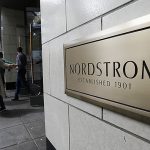Laurie Gilbert traveled down from Freeport Tuesday to look for socks at the Maine Mall. She ended up finding sales she couldnt refuse, and walked away with some compact disks and a pair of shoes — as well as the socks that initially drew her to the mall. The shoes, in particular, were a bargain hunter’s prize.
“Fifty-dollar shoes were on sale for $12,” she said, laughing. “And they were cute.”
Consumers like Gilbert are enjoying deep discounts like that in stores across the country, but falling prices also are causing great pain for the retail industry. Although overall consumer prices are rising modestly, many categories of goods, from toys and TVs to computers, apparel and autos, have been victims of deflation for more than a year.
L.L. Bean Inc. cited price deflation as one of the economic factors that forced the 300 layoffs announced Tuesday. Declining prices in the retail apparel sector, annual wage increases and increasing health care costs continue to put pressure on operating margins, the company said.
It’s easy to see the trend in stores and catalogs. Bean’s cotton polo shirts for men are $19.50 this spring, compared with $22 a year ago. Men’s cotton sweaters are priced at $29.50; a year ago, they were $36.
Circuit City Stores Inc. is selling Kenwood home theater systems for $500; a year ago, they were $700.
At TJ Maxx, run by TJX Cos. Inc., designer-name cashmere sweaters sell for $49 to $129, down $20 from a year ago.
The retail sector is important to Maine and the nation. In December, 23 million people were employed in retail nationwide, according to the Bureau of Labor Statistics preliminary numbers.
In Maine in December, 153,000 were employed in retail, the BLS reported. That represents nearly a quarter of the state’s total work force.
The price-drop trend — which has been spurred by factors such as cheaper imports and excess production capacity built up during the 1990s economic boom — is expected to ease later this year if the economy picks up and the U.S. dollar continues to lose value against foreign currencies. Still, analysts said deflation will remain a major challenge for retailers.
Deflation — a sustained decline in prices in goods and services — is a vicious cycle. A sluggish economy forces businesses to reduce prices, which prompts consumers to delay their spending because they believe even better bargains are in the offing.
Gilbert, for instance, splurged on shoes that were $38 less than originally marked. She said she also was interested in buying a DVD player, but wanted to wait until the price dropped to about $70.
A lack of immediate demand causes retailers to cut prices further to stimulate spending, which in turn hurts profits and leads consumers to expect further price reductions. Meanwhile, the stores are under pressure to cut costs to offset the sales shortfall and maintain profit margins.
Merchants at the Maine Mall said theyve had to drop prices more than usual this winter to move merchandise.
“Our higher-priced items just werent selling this year,” said Chris Mahaney, store manager at Eastern Mountain Sports. “This year, a lot more went on discount.”
For instance, he said, a high-end parka that was priced at $285 is down to an on-tag price of $220 — with an additional 30 percent knocked off that. The yellow sign with the words “Winter Clearance” in six-inch block letters outside the store has brought consumers in, said Mahaney, as has the recent cold weather.
At American Eagle Outfitters, the red sales sign advertised clearance prices with an additional 50 percent off — plus a free CD.
In addition to moving winter merchandise, merchants hope the sales will stimulate business, said assistant manager Kevin Hudson. The store began the discount sales much quicker this year, he said. Normally, the seasonal shift begins in March or April, but $120 winter coats are now down to $30, Hudson said.
“Were basically giving away winter coats in winter,” he said.
Charles Colgan, professor of public policy and management at the University of Southern Maine’s Muskie School of Public Service, said it was important to distinguish between overall macroeconomic deflation and price deflation in certain sectors.
What were seeing now is price deflation in sectors such as clothing and electronics, said Colgan.
“There’s clearly no room to raise prices in a lot of sectors; clothing is one of them,” said Colgan. “That’s why L.L. Bean is facing the problems it is.”
Macroeconomic deflation — when prices remain very low but there’s no demand for the goods — hasnt happened in the U.S. since the Great Depression, he said. Japan, he said, has suffered from such deflation for about a decade, and the situation leads to prolonged economic stagnation.
There are several factors leading to the situation in the U.S., said Colgan. Cheaper foreign-made goods are coming into the country, allowing retailers to drop prices, and consumers can shop online to find the best deals, he explained.
“Basically, the trade deficit and the Internet are putting a lot of competitive pressure on sectors like clothing, and there’s no economic growth in demand to offset that and allow prices to go up somewhat,” said Colgan. “Retailers in particular are essentially caught in a price war with each other to gain market share. They want a bigger share of the pie, or to keep their share of the pie, but the pie isnt growing. Competitive markets benefit the consumers at the expense of the sellers.”
Web technology also factored in L.L. Bean’s layoffs, but in a different way. According to company officials, online sales increased, allowing the company to let go of employees once needed to process orders or deal face-to-face with customers.
Some economists dont believe lower prices are making consumers feel wealthier, mostly because they feel squeezed by higher energy and health care costs.
“Consumers are trapped between price cutting on one hand and price hiking on the other,” said Frank Badillo, senior retail economist at Retail Forward, a consulting firm in Columbus, Ohio.
The lack of pricing power among retailers has forced them to become even more efficient, although analysts question how much more lean they can be.









